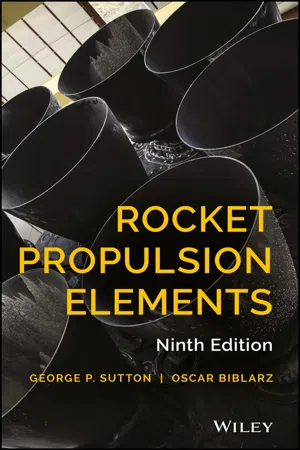
- English
- ePUB (mobile friendly)
- Available on iOS & Android
Rocket Propulsion Elements
About this book
THE DEFINITIVE INTRODUCTION TO ROCKET PROPULSION THEORY AND APPLICATIONS
The recent upsurge in global government and private spending and in space flight events has resulted in many novel applications of rocket propulsion technology. Rocket Propulsion Elements remains the definitive guide to the field, providing a comprehensive introduction to essential concepts and applications. Led by industry veteran George P. Sutton and by Professor Oscar Biblarz, this book provides interdisciplinary coverage including thermodynamics, aerodynamics, flight performance, propellant chemistry and more.
This thoroughly revised ninth edition includes discussion and analysis of recent advances in the field, representing an authoritative reference for students and working engineers alike. In any engineering field, theory is only as useful as it is practical; this book emphasizes relevant real-world applications of fundamental concepts to link "thinking" and "doing". This book will help readers:
- Understand the physics of flight and the chemistry of propulsion
- Analyze liquid, solid, gas, and hybrid propellants, and the engines they fuel
- Consider high-temperature combustion, stability, and the principles of electric and chemical propulsion
- Dissect the workings of systems in common use around the world today
- Delve into the latest advances in materials, systems, propellants, and more
Broad in scope, rich in detail, and clear in explanation, this seminal work provides an unparalleled foundation in aerospace engineering topics. Learning through the lens of modern applications untangles complex topics and helps students fully grasp the intricacies on a more intuitive level. Rocket Propulsion Elements, Ninth Edition merges information and utility building a solid foundation for innovation.
Frequently asked questions
- Essential is ideal for learners and professionals who enjoy exploring a wide range of subjects. Access the Essential Library with 800,000+ trusted titles and best-sellers across business, personal growth, and the humanities. Includes unlimited reading time and Standard Read Aloud voice.
- Complete: Perfect for advanced learners and researchers needing full, unrestricted access. Unlock 1.4M+ books across hundreds of subjects, including academic and specialized titles. The Complete Plan also includes advanced features like Premium Read Aloud and Research Assistant.
Please note we cannot support devices running on iOS 13 and Android 7 or earlier. Learn more about using the app.
Information
CHAPTER 1
CLASSIFICATION
| Energy Sourcea | ||||
| Propulsion Device | Chemical | Nuclear | Solar | Propellant or Working Fluid |
| Turbojet | D/P | Fuel + air | ||
| Turbo–ramjet | TFD | Fuel + air | ||
| Ramjet (hydrocarbon fuel) | D/P | TFD | Fuel + air | |
| Ramjet (H2 cooled) | TFD | Hydrogen + air | ||
| Rocket (chemical) | D/P | TFD | Stored propellant | |
| Ducted rocket | TFD | Stored solid fuel + surrounding air | ||
| Electric rocket | D/P | D/P | Stored propellant | |
| Nuclear fission rocket | TFD | Stored H2 | ||
| Solar‐heated rocket | TFD | Stored H2 | ||
| Photon rocket (big light bulb) | TFND | Photon ejection (no stored propellant) | ||
| Solar sail | TFD | Photon reflection (no stored propellant) | ||
1.1 DUCT JET PROPULSION
Table of contents
- Cover
- Title Page
- Copyright
- Table of Contents
- Preface
- Chapter 1: Classification
- Chapter 2: Definitions and Fundamentals
- Chapter 3: Nozzle Theory and Thermodynamic Relations
- Chapter 4: Flight Performance
- Chapter 5: Chemical Rocket Propellant Performance Analysis
- Chapter 6: Liquid Propellant Rocket Engine Fundamentals
- Chapter 7: Liquid Propellants
- Chapter 8: Thrust Chambers
- Chapter 9: Liquid Propellant Combustion and Its Stability
- Chapter 10: Turbopumps and Their Gas Supplies
- Chapter 11: Engine Systems, Controls, and Integration
- Chapter 12: Solid Propellant Rocket Motor Fundamentals
- Chapter 13: Solid Propellants
- Chapter 14: Solid Propellant Combustion and Its Stability
- Chapter 15: Solid Rocket Motor Components and Design
- Chapter 16: Hybrid Propellants Rocket Propulsion
- Chapter 17: Electric Propulsion
- Chapter 18: Thrust Vector Control
- Chapter 19: Selection of Rocket Propulsion Systems
- Chapter 20: Rocket Exhaust Plumes
- Chapter 21: Rocket Testing
- Appendix 1: Conversion Factors and Constants
- Appendix 2: Properties of the Earth's Standard Atmosphere
- Appendix 3: Summary of Key equations for Ideal Chemical Rockets
- Index
- Wiley End User License Agreement